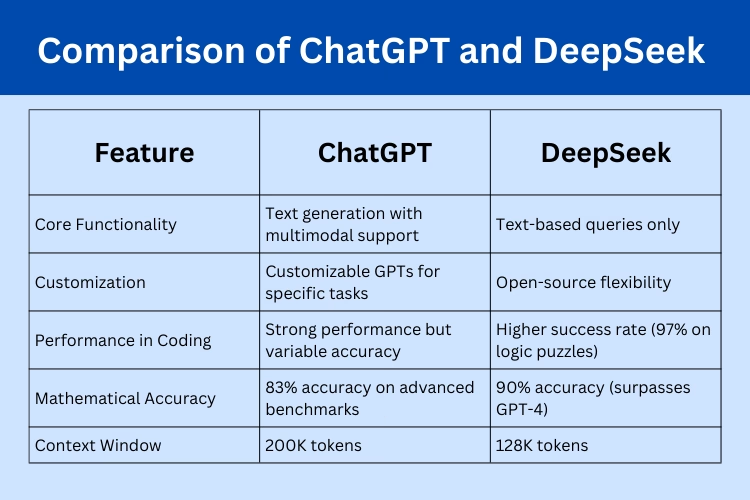In the rapidly evolving landscape of artificial intelligence, two prominent players have emerged: ChatGPT and DeepSeek. Both platforms offer unique capabilities and cater to different user needs, making it essential to understand their strengths and weaknesses. This article provides a detailed comparison of ChatGPT and DeepSeek, highlighting their features, performance, pricing, and ideal use cases.
Overview of ChatGPT and DeepSeek
ChatGPT, developed by OpenAI, is a versatile AI model that excels in generating human-like text across various applications, including content creation, coding assistance, and general knowledge inquiries. It supports multimodal inputs, allowing users to interact through text and images, which enhances its usability for diverse tasks.
In contrast, DeepSeek is a newer entrant in the AI field, known for its efficiency and specialization in technical tasks. Launched in 2023, it has quickly gained popularity as a cost-effective alternative to ChatGPT. DeepSeek focuses on delivering fast responses and high accuracy in areas such as coding and problem-solving.
Comparison Table of ChatGPT and DeepSeek
| Feature | ChatGPT | DeepSeek |
|---|---|---|
| Core Functionality | Text generation with multimodal support | Text-based queries only |
| Customization | Customizable GPTs for specific tasks | Open-source flexibility |
| Performance in Coding | Strong performance but variable accuracy | Higher success rate (97% on logic puzzles) |
| Mathematical Accuracy | 83% accuracy on advanced benchmarks | 90% accuracy (surpasses GPT-4) |
| Context Window | 200K tokens | 128K tokens |
Performance Insights
When it comes to performance, both platforms have their strengths:
- Coding and Technical Tasks: DeepSeek outperforms ChatGPT in coding tasks with a success rate of 97% in logic puzzles compared to ChatGPT’s lower performance metrics. This makes DeepSeek an excellent choice for developers looking for quick debugging and coding assistance.
- Mathematical Problem Solving: DeepSeek also excels in mathematical accuracy with a reported 90% accuracy rate, surpassing ChatGPT’s 83%. This advantage positions DeepSeek as a preferred tool for users needing reliable mathematical solutions.
- General Knowledge Queries: While both platforms can answer general knowledge questions effectively, ChatGPT’s ability to handle multimodal inputs gives it an edge in more complex scenarios that require image analysis or voice interaction.
Pricing Structure
Pricing is a significant differentiator between the two platforms:
- ChatGPT offers a free version based on GPT-3.5 but imposes limitations on usage speed and access to advanced features like GPT-4. Users requiring high-volume queries may find the costs prohibitive due to the tiered pricing structure of its API services.
- DeepSeek, on the other hand, is completely free to use without any limitations on queries. Its API pricing is also significantly lower than that of ChatGPT—charging $0.55 per million input tokens compared to OpenAI’s $15 for similar services. This cost-effectiveness makes DeepSeek particularly appealing to startups and developers working with tight budgets.
Ideal Use Cases
Choosing between ChatGPT and DeepSeek largely depends on user needs:
- For Creative Tasks: If you require an AI that can assist with creative writing, brainstorming ideas, or generating diverse content types, ChatGPT’s versatility makes it an excellent choice. Its ability to generate engaging narratives and handle complex prompts can enhance creative workflows.
- For Technical Applications: Users focused on coding, technical problem-solving, or mathematical inquiries may prefer DeepSeek due to its higher accuracy rates and specialized capabilities. Its open-source nature also allows developers to customize it for specific applications without incurring high costs.
Conclusion
In conclusion, both ChatGPT and DeepSeek represent powerful tools in the realm of artificial intelligence. While ChatGPT excels in versatility and creative tasks due to its multimodal capabilities, DeepSeek stands out for its cost-effectiveness and superior performance in technical applications. Users should evaluate their specific needs—whether they prioritize creative output or technical efficiency—to determine which platform best suits their requirements.
As the AI landscape continues to evolve, both models are likely to undergo further enhancements. Testing both options could provide valuable insights into which platform aligns better with individual or organizational goals.

